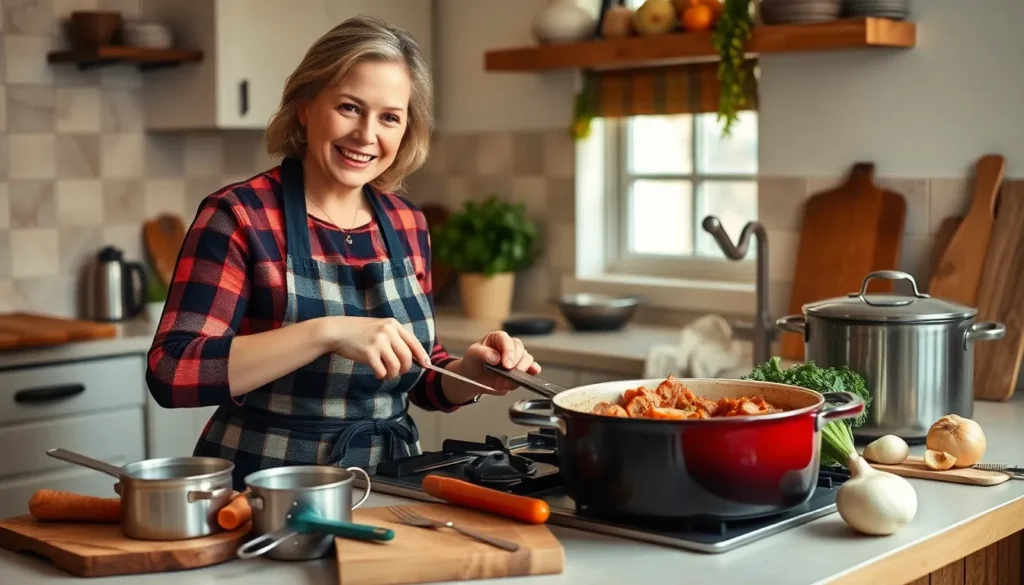When the temperature drops and we’re craving something that’ll warm us from the inside out, nothing beats a hearty stew beef recipe. This tender cut of meat transforms into melt-in-your-mouth perfection when slow-cooked with aromatic vegetables and rich broth.
We’ve perfected this classic comfort food that’s been filling bellies and hearts for generations. Stew beef might seem intimidating to some home cooks, but it’s actually one of the most forgiving cuts you can work with. The secret lies in low and slow cooking, which breaks down those tough fibers into incredibly tender bites.
What makes our stew beef recipe special is how it brings together simple ingredients to create complex flavors. You’ll love how your kitchen fills with incredible aromas while this dish practically cooks itself. Perfect for busy weeknights or lazy Sunday afternoons, this recipe delivers restaurant-quality results with minimal effort.
Ingredients
We’ve carefully selected each ingredient to create the perfect balance of flavors and textures in our hearty stew beef recipe. Our ingredient list focuses on quality cuts of meat paired with fresh vegetables and aromatic seasonings that work together to develop rich depth.
For the Stew Beef
- 2 pounds beef chuck roast, cut into 2-inch cubes
- 3 tablespoons all-purpose flour
- 2 tablespoons vegetable oil
- 1 tablespoon olive oil
For the Vegetables
- 1 large yellow onion, diced
- 3 medium carrots, peeled and cut into 1-inch pieces
- 3 celery stalks, chopped into 1-inch pieces
- 1 pound Yukon Gold potatoes, peeled and quartered
- 8 ounces cremini mushrooms, halved
- 3 garlic cloves, minced
- 2 tablespoons tomato paste
For the Seasonings and Broth
- 4 cups beef broth
- 1 cup red wine
- 2 bay leaves
- 1 teaspoon dried thyme
- 1 teaspoon dried rosemary
- 1 teaspoon salt
- 1/2 teaspoon black pepper
- 2 tablespoons Worcestershire sauce
- 2 tablespoons fresh parsley, chopped for garnish
Equipment Needed
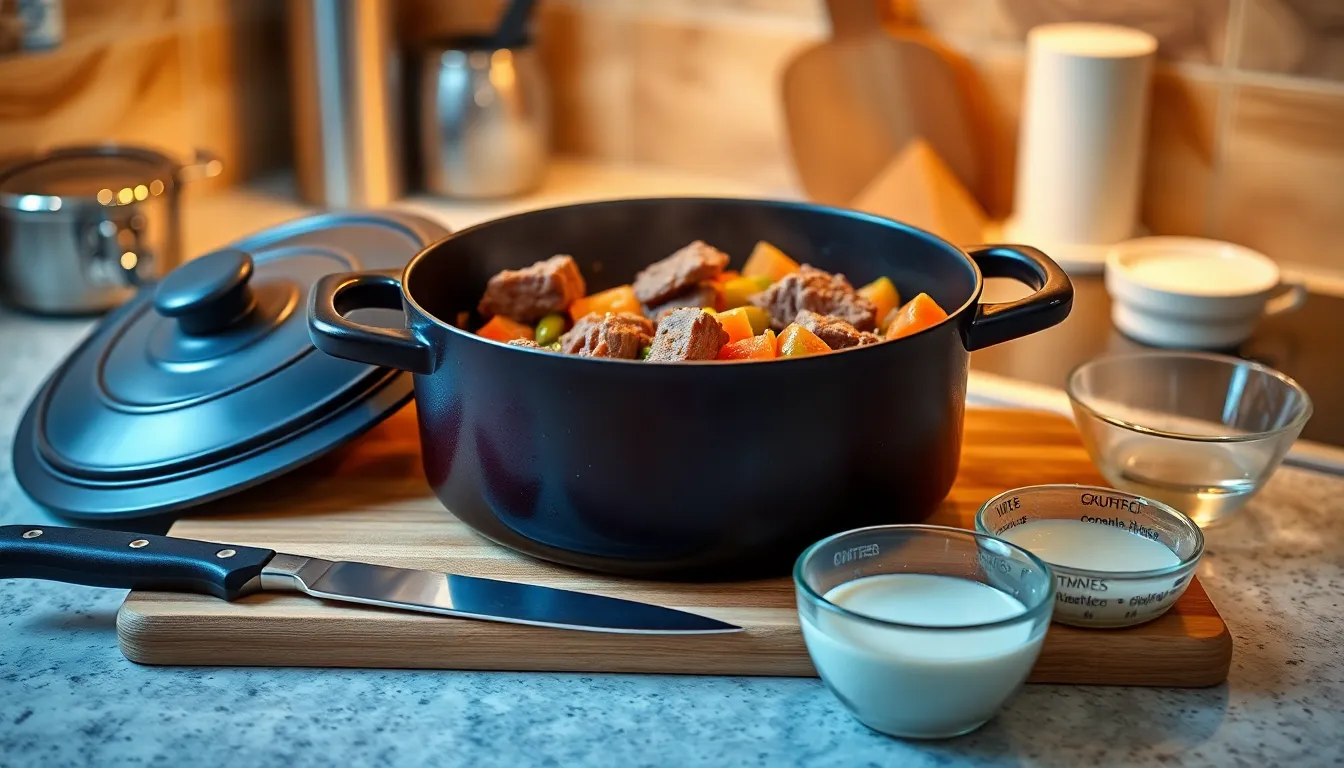
Our stew beef recipe requires essential cookware that transforms simple ingredients into a restaurant-quality meal. We recommend investing in quality tools that deliver consistent results every time.
Large Dutch Oven or Heavy Pot serves as the foundation of our cooking process. This versatile vessel allows us to brown the meat and vegetables before transitioning seamlessly to slow simmering. The heavy bottom prevents scorching while distributing heat evenly throughout the cooking process.
Sharp Knife and Cutting Board enable precise preparation of our ingredients. We need clean cuts on vegetables and properly cubed beef to ensure uniform cooking. A sturdy cutting board provides the stable surface necessary for safe food preparation.
Measuring Tools guarantee accuracy in our recipe execution. Standard measuring cups and spoons help us achieve the perfect balance of seasonings and liquids. Precision in measurements directly impacts the final flavor profile of our stew.
Wooden Spoon or Heat-Resistant Spatula protects our cookware while stirring ingredients. These tools prevent scratching of our Dutch oven’s surface and withstand high temperatures during the browning process. We use them to scrape up those flavorful browned bits from the bottom of the pot.
Small Bowl for Cornstarch Slurry assists in thickening our stew to the perfect consistency. This separate mixing vessel prevents lumps from forming when we combine cornstarch with water. The slurry technique ensures smooth integration into our simmering stew.
Conventional Oven offers an alternative cooking method for hands-off preparation. We can transfer our Dutch oven directly from stovetop to a preheated 325°F oven for slow cooking. This method provides gentle heat that tenderizes the beef without constant monitoring.
Prep Work
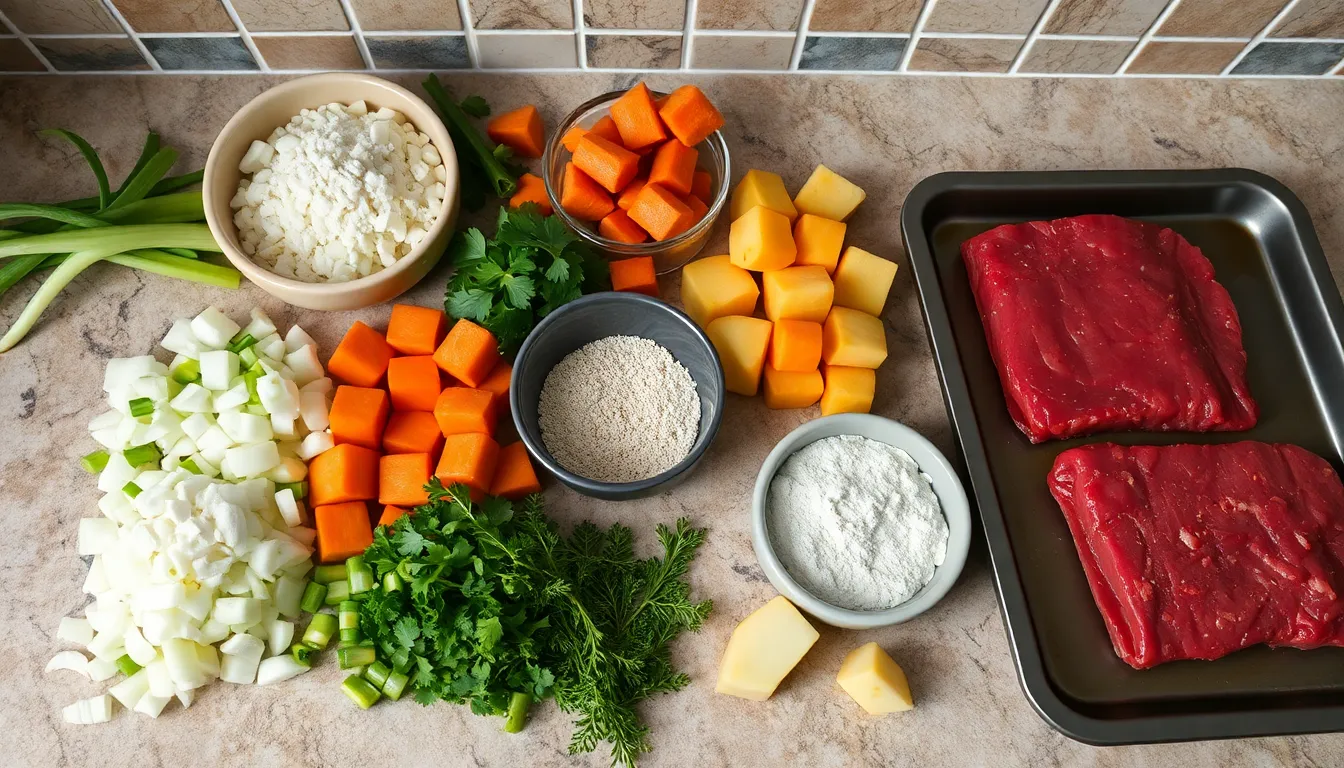
Proper preparation sets the foundation for creating restaurant-quality stew at home. We’ll organize our ingredients efficiently to ensure smooth cooking from start to finish.
Preparing the Beef
We begin by trimming excess fat and connective tissue from our 2 pounds of stew beef. Cut the meat into uniform pieces roughly 1 to 2 inches in size for even cooking and better texture. Season the beef pieces generously with salt and pepper on all surfaces. This initial seasoning penetrates the meat during cooking and builds the flavor base for our entire dish.
Chopping the Vegetables
Start by dicing the onions and celery into small uniform pieces for consistent cooking. Mince the garlic cloves finely to release maximum flavor. Cut carrots and potatoes into larger 1-inch chunks since these vegetables need more time to cook through completely.
We recommend preparing potatoes early and keeping them submerged in cool water to prevent browning while you work on other ingredients. Organize all chopped vegetables in separate bowls before you start cooking for maximum efficiency during the cooking process.
Making the Seasoning Mix
Create our flour coating mixture by combining all-purpose flour with garlic powder, salt, and black pepper in a shallow dish. This seasoning blend serves two important purposes: it helps thicken the stew naturally and adds an extra layer of flavor to the beef.
Mix the ingredients thoroughly to ensure even distribution of seasonings throughout the flour. We’ll use this mixture to coat our seasoned beef pieces completely before browning them in the pot.
Instructions
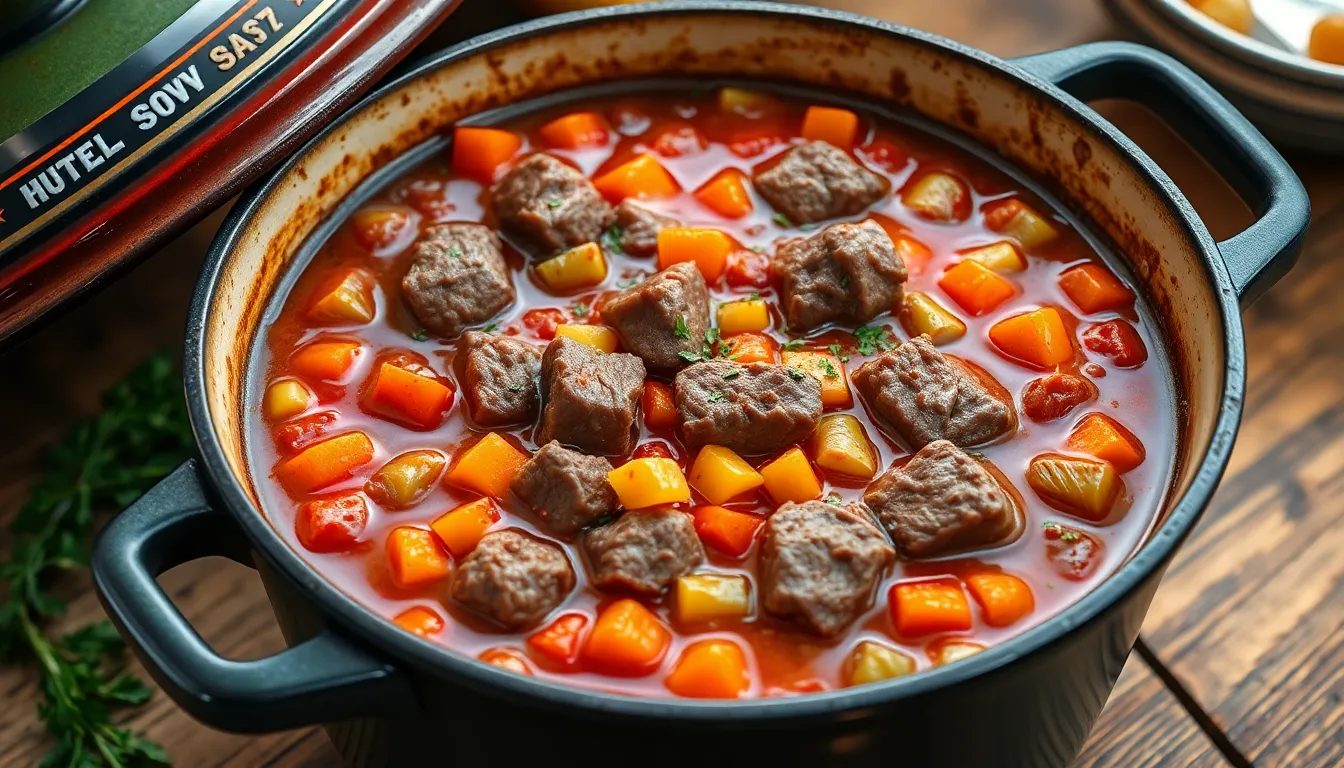
We transform our prepared ingredients into a rich and flavorful stew through four essential steps. Each phase builds upon the previous one to create layers of deep savory taste.
Searing the Beef
Toss the seasoned beef cubes with our flour mixture until evenly coated. Heat 2-3 tablespoons of olive oil in our Dutch oven over medium-high heat until it shimmers. Add the beef in batches to avoid overcrowding the pot. We brown each batch for 3-4 minutes per side until a golden crust forms on all surfaces. Transfer the browned beef to a plate and set aside. Deglaze the pot with a splash of beef broth or red wine while scraping up the browned bits from the bottom with our wooden spoon.
Building the Base
Add the diced onions to the same pot and cook for 2-3 minutes until they begin to soften. Stir in the minced garlic and chopped celery. Cook for another minute until fragrant. Add the carrots and continue cooking until all vegetables are lightly browned and softened. Stir in the tomato paste and cook for 30 seconds until it darkens slightly. Add our fresh herbs including bay leaves and thyme. Return the browned beef to the pot and stir to combine with the aromatic vegetables.
Adding Liquids and Seasonings
Pour in 4-6 cups of beef broth to cover the ingredients completely. Add the red wine if using and stir in the Worcestershire sauce. Season with additional salt and pepper to taste. Scrape any remaining browned bits from the bottom of the pot to incorporate all flavors. Bring the mixture to a gentle simmer while stirring occasionally.
Slow Cooking Process
Cover the pot with a tight-fitting lid and reduce heat to medium-low. Simmer on the stovetop for 1 to 1.5 hours until the beef becomes fork-tender. Alternatively transfer the covered pot to a preheated 325°F oven and cook for 2 to 2.5 hours. Add the potatoes during the last 45 minutes of cooking time. Stir in quick-cooking vegetables like peas during the final 10 minutes. Create a cornstarch slurry by mixing 2 tablespoons cornstarch with cold water and gradually stir into the stew to thicken. Remove the bay leaves before serving and adjust seasoning as needed.
Cooking Methods
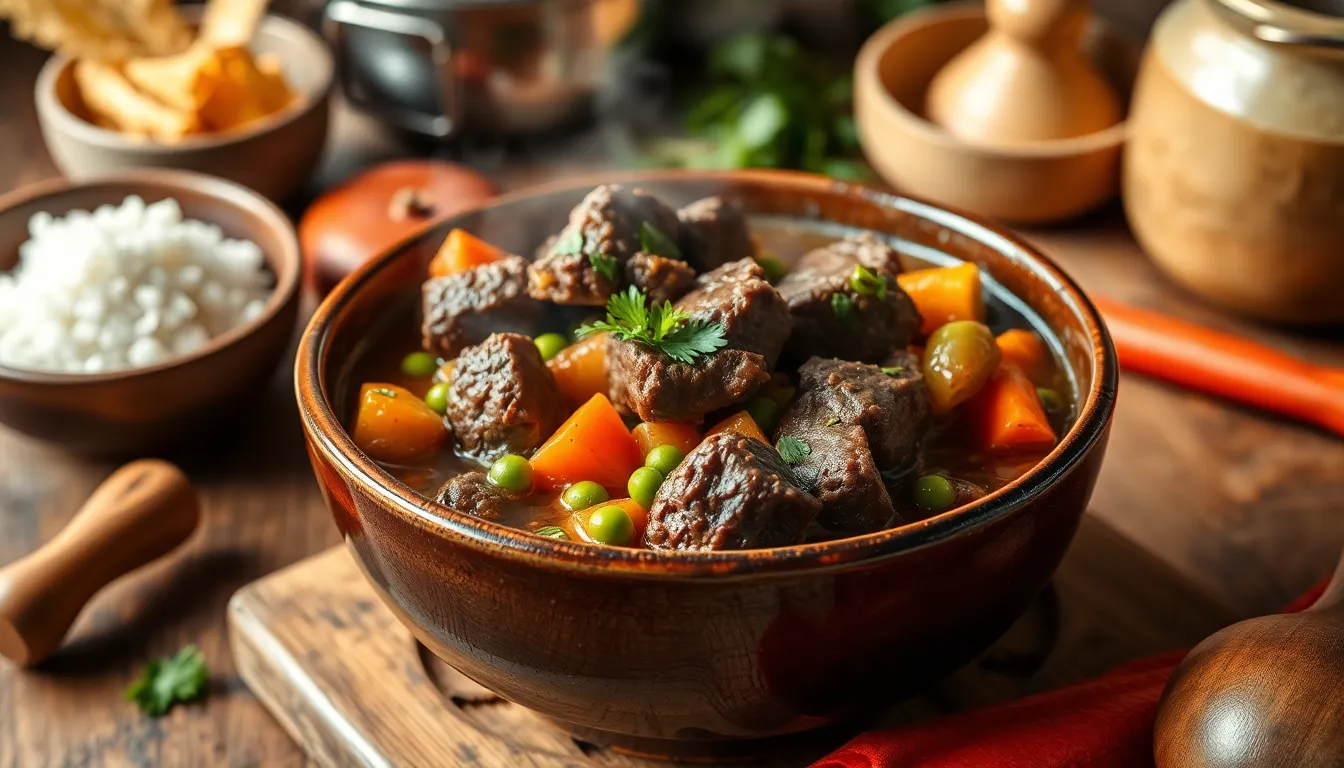
We offer three proven techniques for cooking stew beef that deliver exceptional results. Each method produces tender meat with rich flavors while accommodating different schedules and preferences.
Stovetop Method
We begin by tossing our beef cubes in the flour mixture of garlic powder, salt, and pepper. Heat olive oil in a large Dutch oven over medium-high heat and brown the seasoned beef pieces along with the chopped onion. Add beef broth and optional red wine while scraping up those flavorful browned bits from the bottom of the pot.
Stir in the prepared vegetables, tomato paste, and fresh herbs like rosemary and thyme. Bring the mixture to a boil then reduce heat to medium-low and cover the pot. Simmer for 60 to 90 minutes until the beef reaches fork-tender perfection.
Add peas during the final 15 minutes of cooking to maintain their bright color and crisp texture. Thicken the stew with a cornstarch slurry if desired and adjust seasoning before serving hot.
Slow Cooker Method
We start by browning the beef and onions on the stovetop to develop deep flavors before transferring to the slow cooker. This initial browning step creates the foundation for our rich stew base.
Transfer the browned beef and onions to your slow cooker and add carrots, potatoes, beef broth, herbs, and seasonings. Cook on low for 6-8 hours or high for 3-4 hours until both beef and vegetables are completely tender.
Add peas during the last 30 minutes of cooking to preserve their texture and vibrant color. Create a cornstarch slurry and stir it into the stew to achieve your desired thickness before serving.
Oven Braising Method
We preheat our oven to 325°F for consistent, even heat distribution. Season and flour the beef cubes using our prepared mixture then brown them with onions in an oven-safe Dutch oven over medium-high heat.
Add the vegetables, beef broth, tomato paste, herbs, and seasonings to the Dutch oven. Bring the mixture to a simmer on the stovetop then cover and transfer the entire pot to the preheated oven.
Braise for 2 to 2.5 hours until the beef becomes incredibly tender and the flavors meld beautifully. Remove bay leaves and adjust seasoning before serving this deeply flavored stew.
| Method | Cooking Time | Temperature | Best For |
|---|---|---|---|
| Stovetop | 60-90 minutes | Medium-low simmer | Active cooking control |
| Slow Cooker | 6-8 hours (low) / 3-4 hours (high) | Low/High setting | Hands-off convenience |
| Oven Braising | 2-2.5 hours | 325°F | Even heat distribution |
Tips for Perfect Stew Beef

Mastering the art of stew beef requires attention to three essential elements that transform tough cuts into tender perfection. These proven techniques ensure restaurant-quality results every time we prepare this beloved comfort dish.
Choosing the Right Cut
Beef chuck stands as our top choice for stew beef due to its exceptional marbling and connective tissues that break down beautifully during slow cooking. The marbled fat throughout chuck roast creates incredibly tender meat with rich flavor as it renders during the cooking process. Top sirloin steak offers another excellent option though it requires more careful attention to prevent toughness.
We recommend selecting chuck roast over other cuts because its natural composition makes it nearly foolproof for home cooks. The connective tissues in chuck transform into silky gelatin when cooked low and slow, creating that melt-in-your-mouth texture we all crave in perfect stew beef.
Achieving Tender Meat
Browning the meat first creates the foundation for deeply flavorful stew while developing the Maillard reaction that adds complexity to our dish. We then cook the browned beef slowly at low temperatures for 2 to 2.5 hours using stovetop, oven, or slow cooker methods until it becomes fork-tender.
Maintaining proper moisture levels prevents the meat from becoming tough or dry during the long cooking process. We cover our pot to retain steam and check periodically, adding beef broth or water whenever the liquid level drops too low. This gentle approach allows the tough fibers to break down completely without overcooking.
| Cooking Method | Temperature | Time Range | Best For |
|---|---|---|---|
| Stovetop | Low simmer | 2-2.5 hours | Active monitoring |
| Oven | 325°F | 2-2.5 hours | Hands-off cooking |
| Slow Cooker | Low setting | 6-8 hours | All-day cooking |
Balancing Flavors
Building layers of flavor starts with our aromatic base of onions, garlic, carrots, and celery that we sauté until softened and fragrant. Tomato paste and Worcestershire sauce add essential umami depth while beef broth provides the savory foundation our stew needs.
Fresh herbs like thyme, bay leaves, and parsley contribute earthy notes that complement the rich beef flavors without overwhelming them. Red wine introduces welcome acidity and complexity when added during the deglazing process. We season with salt and pepper at the end of cooking to refine the final flavor balance and ensure our stew tastes perfectly seasoned in every spoonful.
Serving Suggestions

Our perfectly cooked stew beef deserves equally thoughtful accompaniments that complement its rich flavors and hearty texture. We’ve discovered through years of serving this dish that the right sides can transform a simple stew into an unforgettable dining experience.
Potato Pairings
Mashed potatoes create the ultimate comfort food combination when served alongside our beef stew. The creamy texture absorbs the flavorful broth beautifully while adding satisfying richness to each bite. We particularly love garlic mashed potatoes or whipped sweet potatoes for their enhanced flavor profiles that complement the savory stew.
Roasted potatoes offer a delightful textural contrast with their crispy exteriors and fluffy interiors. Baby potato salad with bacon brings smoky elements that enhance the beef’s depth. Smashed potatoes provide rustic charm and countless crevices for soaking up the delicious broth.
Bread Selections
Crusty rustic loaves serve as perfect vehicles for enjoying every drop of our stew’s rich broth. We recommend French bread or Italian bread with herbs for their sturdy crusts that won’t fall apart when dipped. Garlic parmesan knots add buttery richness that pairs exceptionally well with the beef’s savory notes.
Air fryer garlic bread creates an irresistible crispy texture that complements the stew’s tender components. Filipino pandesal rolls offer a slightly sweet contrast that balances the dish’s hearty flavors. Guinness Brown Bread provides a rich and robust flavor that stands up beautifully to our beef stew.
Fresh Contrasts
Light and crunchy side salads balance the stew’s hearty nature while adding refreshing elements to the meal. We find that simple green salads with vinaigrette cut through the richness without overwhelming the palate. Roasted or steamed vegetables provide fresh textures and bright flavors that create perfect harmony with the tender beef and vegetables already in our stew.
These carefully chosen accompaniments work together to create a well-rounded meal that showcases our beef stew while providing variety in texture and flavor throughout the dining experience.
Storage and Reheating

Proper storage extends the life of our delicious stew beef while maintaining its rich flavors and tender texture. We can preserve our homemade stew using simple techniques that ensure food safety and quality.
Refrigerator Storage
We store leftover stew beef in airtight containers in the refrigerator for optimal freshness and safety. Our stew maintains its quality for 3 to 4 days when properly refrigerated.
For easier fat removal, we recommend chilling the stew in the refrigerator for several hours or overnight. The fat solidifies on the surface, allowing us to easily skim it off before reheating. This technique improves both the appearance and healthiness of our stew.
We always allow the stew to cool to room temperature before refrigerating to prevent bacterial growth and maintain food safety standards.
Freezer Storage
Freezing extends our stew’s storage life significantly when we follow proper techniques. We transfer the completely cooled stew to airtight freezer containers or resealable freezer bags, removing as much air as possible to prevent freezer burn.
Our frozen stew beef maintains excellent quality for up to 3 months in the freezer. We label containers with the date to track storage time and ensure we use the oldest portions first.
The key to successful freezing lies in proper container selection and air removal, which prevents ice crystals from forming and affecting the stew’s texture.
Reheating Instructions
| Reheating Method | Temperature/Power | Time | Additional Notes |
|---|---|---|---|
| Stovetop | Medium heat | Until heated through | Add water or broth if needed |
| Microwave | Medium power | 30-second intervals | Stir after each interval |
| Food Safety | Internal temp 165°F | N/A | Use food thermometer |
We reheat our stew beef on the stovetop over medium heat for the best results. Adding small amounts of water or broth helps restore the proper consistency if the stew has thickened during storage.
For microwave reheating, we use 30-second intervals and stir thoroughly after each interval until the stew heats evenly throughout. This prevents hot spots and ensures uniform temperature distribution.
Food safety requires our reheated stew to reach a minimum internal temperature of 165°F. We use a food thermometer to verify the temperature before serving.
If our reheated stew appears too watery, we simmer it uncovered to reduce excess liquid or thicken it with a cornstarch and water slurry.
Recipe Variations
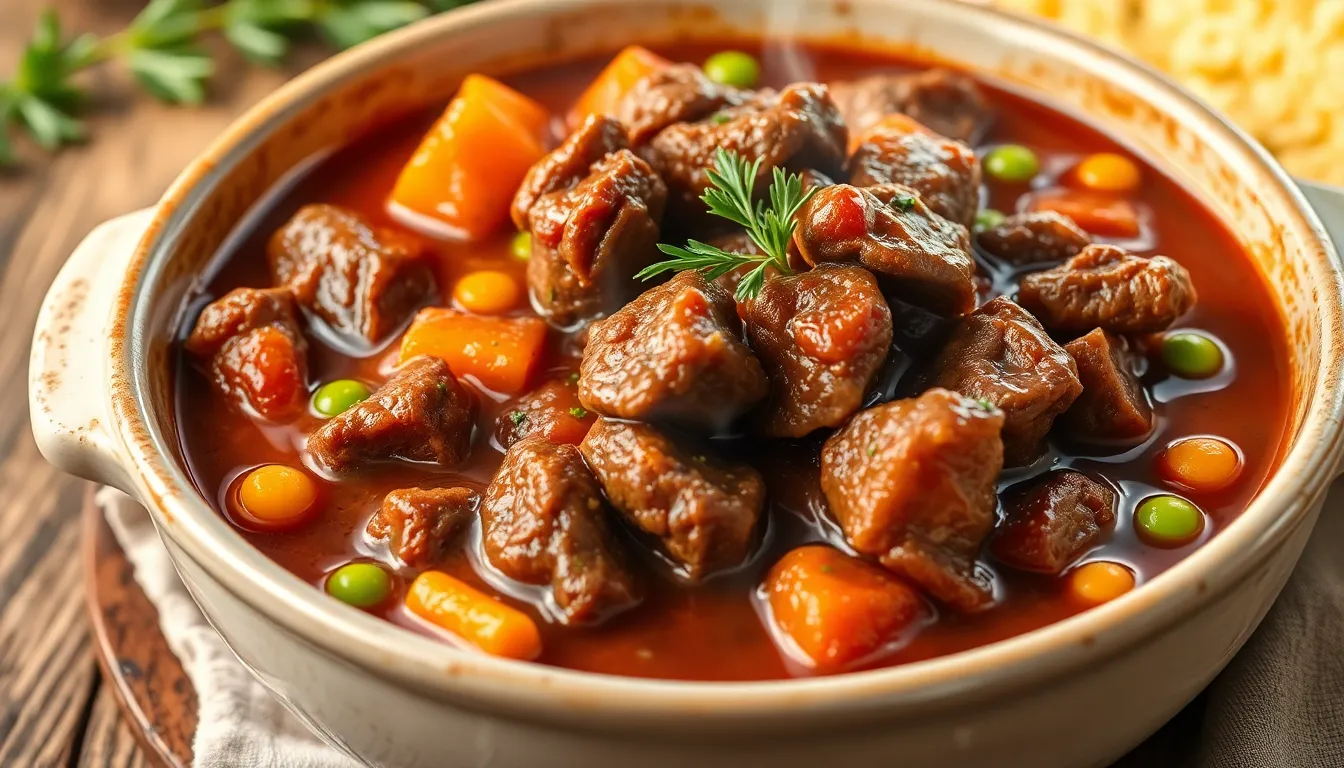
Building on our foundation recipe, we can transform stew beef into exciting culinary adventures from around the industry. These variations showcase how the same tender meat becomes the star of completely different flavor profiles.
Classic Beef Stew
We start by coating 2 pounds of cubed stew beef in our seasoned flour mixture of salt, pepper, and all-purpose flour. Brown the beef thoroughly with chopped onions in olive oil to develop that essential flavor base we discussed earlier. Add 6 cups of beef broth along with optional red wine for depth, then incorporate potatoes, carrots, celery, tomato paste, and fresh rosemary.
| Cooking Method | Time Required | Temperature |
|---|---|---|
| Stovetop Simmer | 1 to 1.5 hours | Medium-low heat |
| Oven Braising | 2 to 2.5 hours | 325°F |
We finish by thickening the stew with a cornstarch slurry if needed and stirring in fresh or frozen peas during the final minutes of cooking. This approach ensures our beef reaches that perfect fork-tender texture while maintaining vibrant vegetable colors.
Mediterranean Style
Our Mediterranean variation builds on the classic foundation but elevates the flavor profile with distinctive regional ingredients. We substitute extra virgin olive oil for regular oil and increase the garlic quantity for authentic Mediterranean boldness. Bay leaves and red wine vinegar join the aromatics, while fresh thyme becomes our finishing garnish instead of rosemary.
The transformation happens when we add olives, sun-dried tomatoes, or marinated artichoke hearts during the final 30 minutes of cooking. These tangy accents distinguish this version from our traditional stew, creating layers of flavor that transport us straight to the Mediterranean coast. We maintain the same cooking times as our classic version while adjusting herbs and seasonings to match this regional style.
Asian-Inspired Version
We take our beef base in an entirely different direction with Asian seasonings that create depth through umami-rich ingredients. Soy sauce, fresh ginger, and star anise replace our traditional herbs, while we substitute regular beef broth with a mixture of beef stock, soy sauce, and rice wine for authentic flavor development.
Vegetables shift dramatically in this variation as we replace carrots and potatoes with daikon radish, shiitake mushrooms, and fresh leeks. The cooking method remains identical to our classic approach, but we serve this version over steamed rice instead of with bread. This adaptation demonstrates how stew beef adapts beautifully to different culinary traditions while maintaining its signature tenderness through low and slow cooking techniques.
Make-Ahead Instructions
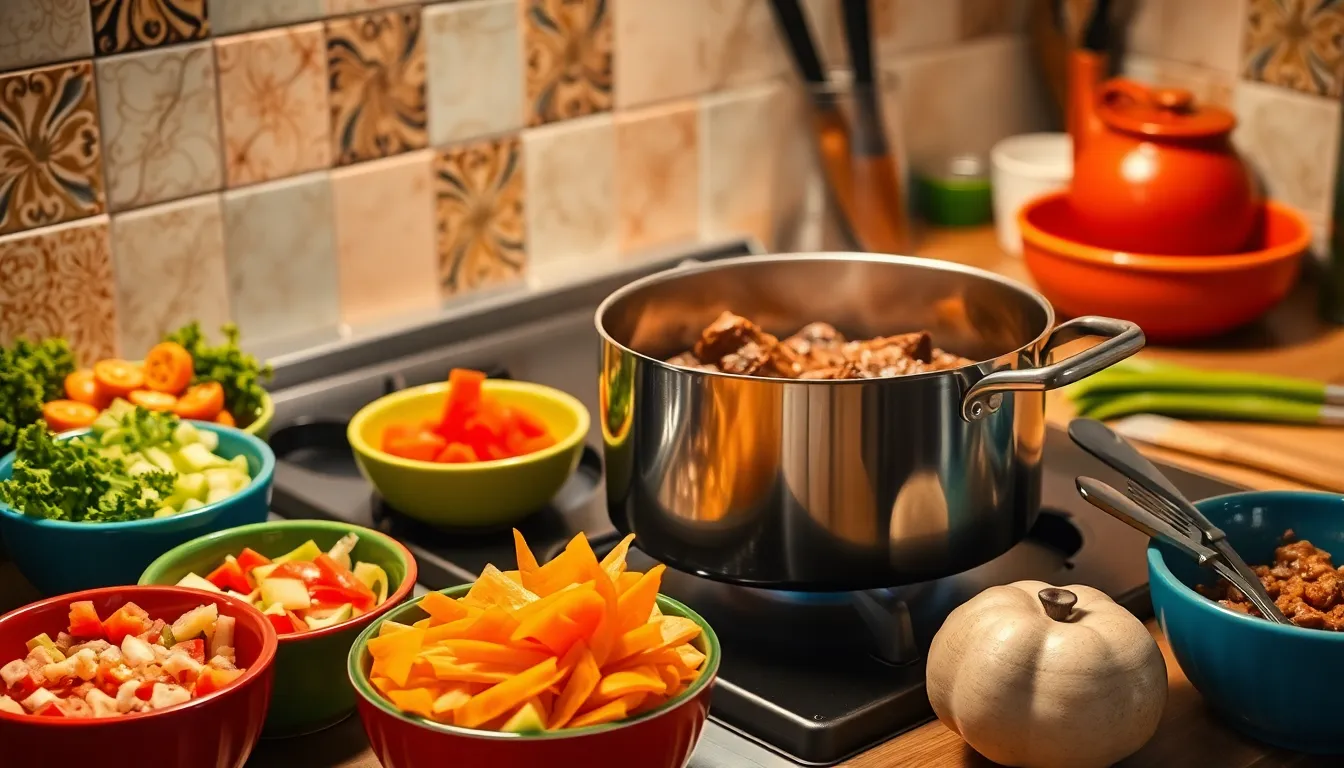
We understand that planning ahead can make weekday meals significantly easier. Our stew beef recipe adapts beautifully to advance preparation methods that save time without compromising flavor.
Full Stew Preparation
Prepare the complete stew following our cooking instructions through the final simmering stage. Allow the finished stew to cool completely at room temperature before transferring to airtight containers. Store in the refrigerator for up to 3 days, where the flavors will actually deepen and improve during this resting period.
When ready to serve, reheat the stew gently on the stovetop over medium heat. Stir occasionally and add small amounts of beef broth if the consistency becomes too thick. We recommend tasting and adjusting seasonings after reheating since flavors can mellow slightly during storage.
Component Preparation Strategy
Breaking down the preparation into manageable steps streamlines the cooking process significantly. Cube the stew beef and toss with our seasoning mixture up to 24 hours in advance. Store the seasoned meat in the refrigerator in a covered container.
Chop all vegetables and organize them in separate containers based on when they enter the cooking process. Onions, celery, and carrots can be prepared up to 2 days ahead, while potatoes should be cut no more than 24 hours in advance to prevent browning.
Create the flour and seasoning mixture in advance and store in an airtight container. This preparation method allows you to brown the meat and begin cooking immediately when ready.
Freezing Guidelines
Our stew beef recipe freezes exceptionally well for up to 3 months when stored properly. Cool the completed stew to room temperature before portioning into freezer-safe containers. Leave approximately one inch of headspace to allow for expansion during freezing.
Thaw frozen stew overnight in the refrigerator for best results. Reheat slowly on the stovetop, stirring frequently and adding liquid as needed. The texture may require slight adjustment with additional cornstarch slurry if the stew appears too thin after thawing.
| Storage Method | Duration | Best Practices |
|---|---|---|
| Refrigerated Complete Stew | 3-4 days | Cool completely before storing |
| Prepared Components | 1-2 days | Store vegetables separately |
| Frozen Complete Stew | 3 months | Use airtight containers with headspace |
| Seasoned Raw Beef | 24 hours | Keep refrigerated in covered container |
Reheating Techniques
Stovetop reheating provides the most control over texture and consistency. Place the stew in a heavy pot over medium heat and stir occasionally until heated through. This method takes approximately 15 to 20 minutes for refrigerated stew.
Oven reheating works well for larger portions. Transfer the stew to an oven-safe dish, cover tightly with foil, and heat at 350°F for 25 to 30 minutes. Stir halfway through the reheating process to ensure even warming.
Microwave reheating offers convenience for individual portions. Use 50% power and heat in 90-second intervals, stirring between each interval until the internal temperature reaches 165°F throughout.
Conclusion
We’ve shown you that creating exceptional stew beef doesn’t require years of culinary training or expensive ingredients. With the right cut of meat proper technique and patience you’ll transform simple chuck roast into a restaurant-quality meal that’ll have your family asking for seconds.
The beauty of this recipe lies in its flexibility and forgiving nature. Whether you choose the stovetop slow cooker or oven method you’re guaranteed tender meat and rich flavors. The make-ahead options and storage tips we’ve shared make this dish perfect for meal planning and busy schedules.
Now it’s time to roll up your sleeves gather your ingredients and start cooking. Your kitchen will soon be filled with the incredible aromas of this comforting stew and you’ll understand why this classic dish has stood the test of time.
Frequently Asked Questions
What is the best cut of beef for stew?
Beef chuck roast is the ideal cut for stew due to its marbling and connective tissues that break down beautifully during slow cooking, creating tender, melt-in-your-mouth meat. Top sirloin can also work as an alternative, but requires careful attention during cooking to prevent toughness.
How long does it take to cook stew beef?
Cooking time varies by method: stovetop simmering takes 60-90 minutes, slow cooker requires 6-8 hours on low or 3-4 hours on high, and oven braising needs 2-2.5 hours at 325°F. The key is cooking until the meat is fork-tender.
Can I make beef stew ahead of time?
Yes, beef stew can be made up to 3 days in advance and stored in the refrigerator. The flavors actually improve over time. You can also prepare components separately – beef up to 24 hours ahead and vegetables up to 2 days ahead.
What vegetables work best in beef stew?
Classic vegetables include onions, carrots, potatoes, and celery. These vegetables hold their shape well during long cooking and complement the beef’s rich flavors. Add potatoes later in the cooking process to prevent them from becoming mushy.
How do I thicken beef stew?
Create a cornstarch slurry by mixing cornstarch with cold water, then stir it into the simmering stew. Alternatively, coating the beef with seasoned flour before browning helps naturally thicken the stew while adding flavor.
Can beef stew be frozen?
Yes, beef stew freezes well for up to 3 months in airtight containers. Cool completely before freezing, and reheat gently on the stovetop or in the microwave, ensuring it reaches 165°F internal temperature for food safety.
What should I serve with beef stew?
Serve beef stew with crusty bread, creamy mashed potatoes, or roasted potatoes to soak up the rich broth. Light side salads or roasted vegetables help balance the stew’s hearty richness and create a well-rounded meal.
How do I store leftover beef stew?
Store leftover stew in airtight containers in the refrigerator for 3-4 days. Chill the stew first to remove excess fat, then reheat gently on the stovetop over medium heat or in the microwave in 30-second intervals.
What’s the secret to tender stew beef?
The secret is low and slow cooking, which breaks down tough connective tissues. Brown the meat first to develop flavor, maintain proper moisture levels, and avoid rushing the cooking process. Patience is key to achieving fork-tender results.
Can I make beef stew variations?
Absolutely! Try Mediterranean style with olives, garlic, and bay leaves, or Asian-inspired versions with soy sauce, ginger, and shiitake mushrooms. The same cooking methods apply – just swap seasonings and vegetables to create exciting flavor profiles.

